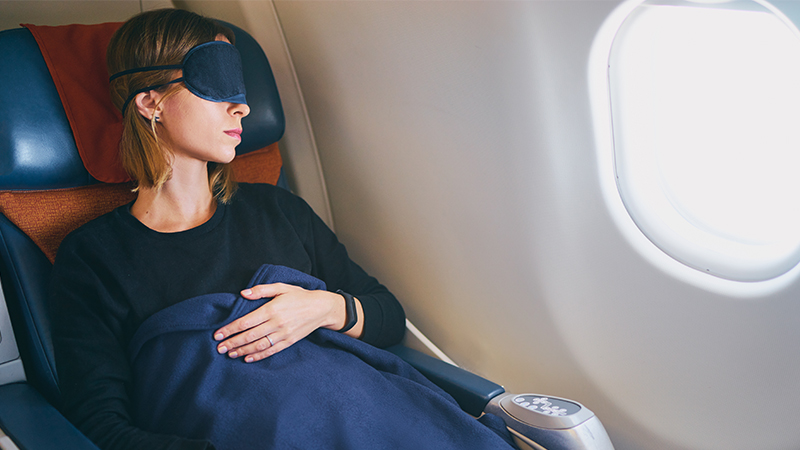How to Survive a Red-Eye Flight and Embrace Sustainability
In an era where environmental concerns are paramount, it is essential to approach even the most routine aspects of modern life, such as air travel, with an eco-conscious mindset. According to the International Air Transport Association (IATA), aviation generates around 2-3% of global greenhouse gas emissions. This statistic underscores the imperative for individuals particularly those who travel frequently for work or leisure—to adopt sustainable practices while in transit. 
As we examine strategies for surviving a red-eye flight, we can simultaneously consider our impact on the planet and explore how we can mitigate our carbon footprint.
The Sustainable Traveler: Navigating Red-Eye Flights
Red-eye flights, characterized by their overnight schedule, can be both advantageous and challenging. These late-night journeys open up the day for productive activities upon arrival, yet they often leave travelers feeling drained and exhausted. To bridge the gap between convenience and sustainability, consider the following insights on how to enhance your travel experience while being mindful of the environment.
1. Choose Direct Flights
Opting for non-stop flights reduces the need for fuel consumption that comes with layovers and multiple takeoffs and landings. In addition, airlines that implement modern fuel-efficient technologies can significantly decrease emissions. Before booking, check the airline’s sustainability initiatives—many are increasingly committed to reducing their environmental impact.
Learn more about eco-friendly flying practices at Green Air.
2. Pack Light and Smart
Heavy luggage not only makes your travel experience cumbersome but also contributes to increased fuel consumption. Opt for lightweight, multifunctional packing strategies to minimize your baggage.
The following tips can aid in smart packing:
- Use a carry-on bag: This reduces wait times at baggage claim and promotes efficiency.
- Choose efficient clothing: Fabrics that are quick-drying and wrinkle-resistant can serve multiple purposes and require less frequent laundering.
3. Stay Hydrated Responsibly
Flying can dehydrate the body due to the low humidity levels in the cabin. Staying hydrated is crucial for feeling your best after an overnight flight.
However, single-use plastic water bottles contribute to environmental degradation. Instead:
- Bring a reusable water bottle: Fill it up after passing through security. Many airports are equipped with water refill stations, allowing for a sustainable and cost-effective hydration solution.
4. Embrace Sustainable Snacks
Airport and airplane food options often lean towards convenience over sustainability. By bringing your own snacks, you can control what you consume while avoiding excessive packaging. Consider:
- Local and organic snacks: Nuts, dried fruits, and whole-grain bars are excellent choices that reflect a commitment to sustainable sourcing.
- Avoid individual packaging: Opt for bulk snacks that reduce waste.
5. Mind Your Power Usage
Red-eye flights typically cover long distances, making your devices essential for entertainment and work.
However, excessive power usage can strain resources. To practice sustainable device management:
- Charge devices beforehand: Fully charge your devices before your flight to minimize the need for in-flight charging.
- Utilize battery-saving modes: Engage power-saving features to extend device life.
6. Offset Your Carbon Footprint
While carbon offsetting cannot eliminate your travel emissions, it is a valuable tool for the environmentally conscious traveler. Many airlines now offer options to contribute to carbon offset projects when purchasing tickets.
To further your impact:
- Calculate your carbon footprint: Use tools like Carbon Footprint’s calculator to quantify and understand your travel emissions.
- Contribute to reputable offset programs: Allocating funds to verified initiatives such as reforestation projects can foster your journey towards sustainable travel.
7. Optimize Sleep for Recovery
To successfully manage fatigue during a red-eye flight, prioritizing rest is paramount. Adequate rest supports cognitive function and mood, reducing the adverse effects of travel.
Ensure a good sleep environment by:
- Using a sleep mask and earplugs: These accessories help block out light and noise.
- Layering for comfort: Dress in breathable and temperature-regulating clothing, allowing for comfort throughout the flight.
Conclusion
Traveling sustainably reflects a broader commitment to environmental stewardship. Whether you fly often or only occasionally, incorporating eco-friendly practices into your travel routine can substantially reduce your carbon footprint and promote a healthier planet.
Actionable Tips for Environmentally Conscious Travelers:
- Research your airline's sustainability practices: Select airlines actively working to minimize their environmental impacts.
- Adopt a minimalist packing strategy: Travel light to lighten your environmental load.
- Support local, sustainable brands: Whether choosing snacks or traveling essentials, prioritize products that emphasize ethical sourcing.
- Engage in carbon offsetting: Actively participate in efforts to mitigate travel emissions through reputable programs.
In conclusion, eco-conscious individuals can turn the challenge of red-eye flights into an opportunity to enhance their travel experience while contributing positively to the environment. By implementing these strategies, not only do travelers arrive at their destination refreshed, but they also champion a sustainable approach to travel that promotes the well-being of our planet.
Discover more sustainable travel practices with organizations like The Nature Conservancy for further insights on how to protect our natural world while exploring it.
By prioritizing sustainability in every journey, we can collectively work towards a greener future.
















![[LIVE] Engage2Earn: Veterans Affairs Labor repairs](https://cdn.bulbapp.io/frontend/images/1cbacfad-83d7-45aa-8b66-bde121dd44af/1)
